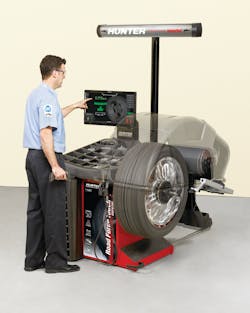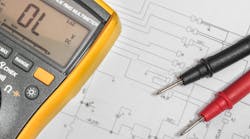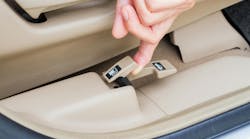Vehicle Application:
1998 Explorer 4.0
Customer Concern:
There is a vibration that can be felt in the steering wheel and in the seat.
Average Reported Mileage: 80305
Tests/Procedures:
Step 1
Vibrations can sometimes be narrowed down by when the vibration occurs.
a. If the vibration can be duplicated in the stall simply by increasing the RPMs, it is likely engine related. Remove the serpentine belt; if the vibration is gone, check all driven components.
b. If the vibration is only there with the vehicle moving, but goes away when put into neutral, it is likely a drive line vibration; begin checking driveshaft and rear differential.
c. If the vibration is clearly speed related, but not RPM related, and it is unaffected by engine speed and transmission gear, suspect tires, wheels, or bearings.
Step 2
When it comes to tires, balance and condition are important, but road force balance is becoming more important on today's cars and trucks. If suspecting a tire/wheel problem, but the tires are balanced ok, have them road force balanced.
Step 3
When traditional diagnosis will not work, there is an electronic vibration analyzer that may assist in diagnosis. This will tell you what frequency the vibration is happening at, low frequency like 10 or 13 hertz, will verify a tire/wheel/bearing issue.
Running or Rolling?
The techniques described in Step 1 will help you decide if the vibration is in the engine chassis. Since engine vibration can be found without any special tools, we’ll focus on chassis vibrations.
When it’s confirmed that a vibration occurs only when the vehicle is moving, most techs will check wheel balance first, and that’s the most common problem. But as many have discovered, a wheel-and-tire assembly can be perfectly balanced on the machine but still feel unbalanced on the road. Why?
Even if a tire looks to be in good condition it can still have internal damage to the carcass. Most tires develop a flat spot in the carcass when the vehicle sits for long periods. Usually the carcass recovers its shape as the tire rolls up to normal operating temperature, but sometimes the flat spot becomes permanent.
The carcass gives the tire its shape and structure, and it supports the load being carried on that wheel. As it rolls down the road, the inflated tire acts like springs arranged like the spokes of a wheel. If the carcass is damaged or not perfectly round, stiffer at one spot or softer at another, it will act as though one of those spoke-like springs is stiffer or weaker than the others. As speed increases, the tire will hop as though it’s imbalanced, even if the balance is perfect. A high or low spot in the wheel will have a similar effect.
A wheel balancer with a road force roller will help you find the weak/stiff spots in the tire carcass and any high or low spots in the wheel.
Road Force Wheel Balance
A road force wheel balancer has a roller that puts up to 1400 pounds of load against the tire as it spins on the balancer. It measures the force with which the tire pushes back. Ideally that push-back force should be equal all the way around the tire. Depending on the type of vehicle, if the push-back force at any one spot is different (high or low) by more than about 15 pounds, you would probably feel it as the car rolls down the road. At 25 pounds difference, most of your customers would feel it too.
Car manufacturers have been using road force wheel balancers for decades. Why? Not even new tires are perfect, and especially not tires and wheels that have been on the road for a few years. The imperfections are usually small enough to go unnoticed, unless they happen to be in the same place. By finding the imperfections in the tire and any high or low spots on the wheel, you can mount the tire on the wheel with the imperfections 180 degrees away from each other, so they cancel each other out. This is called match mounting, and it’s done at the factory on every wheel-and-tire assembly to create that impressive new-car-ride.
A road force wheel balancer is now available to the aftermarket too; the Hunter GSP9700. Most manufacturers “encourage” their dealers own one of these machines, and virtually all have issued Service Bulletins about using it to solve difficult wheel balance problems.
Calibration
No matter what kind of wheel balancer you have, its calibration should be checked at least once a month. The job is surprisingly easy because only three things are needed: a straight wheel, wheel weights and the owner’s manual.
The procedure varies depending on the manufacturer and capabilities of the machine, but the basic concept is always the same. A wheel of known dimensions is spun and a baseline measurement is taken. Next, a known amount of weight is added to create a specific imbalance. The wheel is spun again, and if the imbalance matches the amount of weight added, calibration is correct. If it’s not correct, that’s when you need the owner’s manual.
It may be simple, but there are some important details. First of all, the wheel must be straight. On some balancers, a wheel of specific size must be used, and if a cone is used to center the wheel on the balancer shaft, the wheel must be hub centric (many wheels are centered by the studs, not the hub). Some shops keep a new steel wheel (without a tire) to use as their ‘calibration’ wheel.
Some balancers are shipped with the calibration weights that were used at the factory when the machine was built. These must be used to check calibration in the shop too. Whether using those weights or your own, calibration weights are usually fairly hefty, at least 3 ounces (85 grams). This makes the procedure easier and more accurate.
Hub Centered vs Stud Centered
There are two different ways to center the wheel on the axle when it’s mounted on the vehicle: hub centric and stud centric. Hub centric wheels fit onto a slight extension of the hub or brake drum. This assures that the tire mounting bead is exactly concentric with the axle. Many aftermarket wheels are hub centric but have an oversized hub hole, so centering rings are needed to make them fit on the vehicle. Wheels that are centered by the wheel studs are typically used on larger vehicles, including SUVs and light trucks. The hole in the center of the wheel is often exactly centered, BUT NOT ALWAYS.
When mounting wheels on a wheel balancer, you need to know which type of wheel you’re working with. For stud centric wheels, an adapter plate is needed. They are available with every wheel balancer, and there are several aftermarket adapters too. Most are adjustable for different size bolt patterns. When mounting a wheel on an adapter, make sure to torque the nuts evenly.
Chassis Vibrations
Wheels and tires are only one possible source of road vibration, especially in the older 3700-pound full-frame 4-WD truck driven by our customer. Vibration can also come from other parts of the chassis, including axles or driveshafts, wheel bearings, worn suspension bushings and even faulty motor mounts.
Almost any vibration that can be felt produces noise too. Most techs are familiar with using a long screwdriver as a stethoscope to locate noise, but that’s not really possible when the car is being driven. However, there are tools designed for exactly that purpose.
Steelman Chassis Ears are small radio transmitters that have a clamp with a built-in microphone. With the clamp attached to a suspected problem area and the transmitter secured to the vehicle, the signal from this electronic stethoscope is transmitted to a 4-channel receiver. A tech uses headphones to listen to each transmitter one at a time while someone else drives. It takes a little practice and experience with known-good vehicles, but this tool can help you quickly find the exact location of any noise or vibration from gears, bearings or suspension pieces while under load. It’s especially useful on trailers (transmitter range is 50 feet).
A Black Art
Unlike using scanners and scopes to diagnose engine problems, finding a vibration is more of an art. A bad axle bearing or dragging brake caliper might produce more vibration than noise, and finding something like that requires imagination and resourcefulness, plus the ability to ‘think outside the box.’ So imagine how you would like to test your theory, then look in your toolbox, look around the shop and look in the pages of this magazine to find the tools that will help you get the job done.


